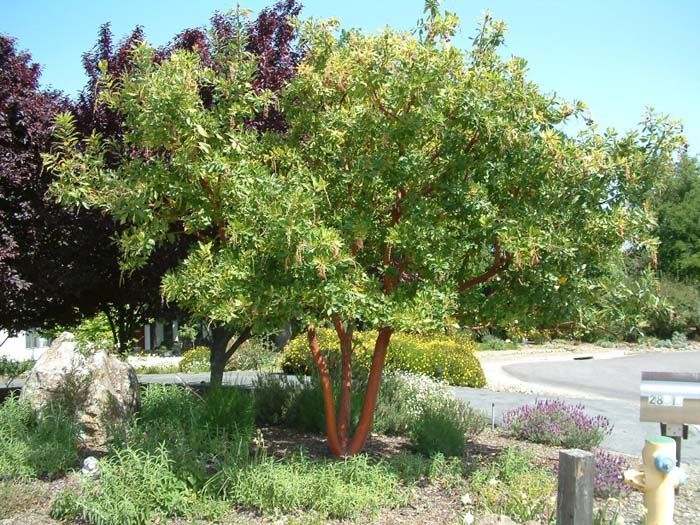The marina strawberry tree (Arbutus x ‘Marina’) is an eye-catching ornamental tree that offers year-round interest and adaptability. As it reaches its mature size, the marina strawberry tree develops into a stunning landscape specimen. Let’s explore why full grown marina strawberry trees can be the perfect addition for gardens across various USDA hardiness zones.
Overview of the Marina Strawberry Tree
Native to the Mediterranean region, the marina strawberry tree is an evergreen hybrid that combines the genetics of the Arbutus unedo and Arbutus canariensis. It was cultivated by the renowned Monrovia nursery in California.
The marina strawberry tree is considered relatively fast-growing averaging about 1-2 feet of growth per year. It typically matures in the range of 25-40 feet tall and 15 feet wide. The tree has an upright yet rounded form with reddish-brown peeling bark that provides great winter interest.
The large, glossy green leaves set it apart from some other Arbutus varieties. The foliage emerges bright red before maturing to deep green. Clusters of small urn-shaped pink flowers bloom from fall through late winter. These blossoms give way to bumpy red fruits resembling strawberries, hence the common name. The marina strawberry tree fruits and flowers simultaneously for striking multi-season display.
Growing Conditions for Marina Strawberry Trees
One of the great qualities of the marina strawberry tree is its adaptability to various climates and soils, Here are its basic needs
- USDA Zones: 7-10
- Sun: Full sun
- Soil: Average to poor, well-draining
- Water: Low to moderate once established
This versatility makes the marina strawberry tree suitable for Southwest gardens as well as coastal environments. It tolerates heat, wind, salt spray, and drought. Provide regular irrigation for the first year or two to help establish an expansive root system. After that, it only requires occasional deep soakings.
The marina strawberry tree thrives in lean soils and needs little fertility once settled in. Avoid overwatering or over-fertilizing for best growth. It has few pest or disease issues, though watch for scale insects. Deer tend to leave it alone thanks to the leathery foliage.
The Form and Function of Mature Marina Strawberry Trees
When allowed to grow to its full mature size, the marina strawberry tree takes on a beautifully rounded, upright form. It looks attractive as a stand-alone specimen or planted in groupings. The peeling cinnamon-colored bark provides nice winter interest.
The large evergreen leaves cast dappled shade below. These glossy green leaves turn vivid red before maturing, so you get a great show of foliage color. The cool thing about full grown marina strawberry trees is that they bloom and fruit simultaneously. You get delicate pinkish urn-shaped flowers appearing at the same time as the decorative red, strawberry-like fruits.
In addition to offering year-round visual appeal, mature marina strawberry trees have functional uses in the landscape. Their rounded canopy can provide shelter from winds when used as a windbreak. The trees also make a great screen for privacy or blocking unsightly views.
The leathery foliage is quite drought and fire resistant once established, making the trees ideal for xeriscaping and fire-wise plantings. Marina strawberry trees attract birds who feast on the fruits. You can also harvest the mild, sweet berries yourself for jams or other recipes.
Tips for Growing Healthy Marina Strawberry Trees to Maturity
Getting your marina strawberry tree off to a good start is key to helping it reach its full mature size and form. Here are some tips for success:
-
Select a spot with full sun and well-draining soil. Avoid soggy or clay-heavy locations.
-
Water young trees regularly for the first 1-2 years to develop an extensive root system.
-
Apply a balanced fertilizer or slow-release formula in early spring. Avoid high-nitrogen products.
-
Prune lightly in spring to shape the canopy and remove any dead branches. Avoid heavy pruning.
-
Watch for scale insects on leaves and stems. Control with horticultural oil or insecticidal soap sprays.
-
Apply organic mulch around the root zone to conserve moisture and suppress weeds.
-
Irrigate mature trees occasionally during droughts for best fruiting and flowering.
Enjoying the Benefits of Full Grown Marina Strawberry Trees
Allowing marina strawberry trees time to reach their mature size rewards you with an incredibly versatile and adaptable evergreen specimen. The year-round interest, wildlife benefits, edible fruits, and functionality check off a lot of boxes that today’s gardeners look for.
Incorporating one or more full grown marina strawberry trees can provide food and shelter for birds, visual interest across the seasons, and space definition and screening. Plus you get the added benefit of harvesting your own ornamental edible fruits!
If you have the garden space and patience to let them grow, mature marina strawberry trees will transform into stunning focal points. They make great anchors for Mediterranean gardens, wildlife gardens, native plantings, or specimen gardens. They reflect the intersection of beauty and utility that marks the best landscape plants.
Amazing Bark, Amazing Tree! Arbutus Marina (Marina Strawberry Tree)
FAQ
How big do marina strawberry trees get?
Are marina strawberry trees messy?
How do you care for a marina strawberry tree?
How long does it take for a strawberry tree to bear fruit?
- The Ultimate Guide to Growing Strawberries in Raised Beds - August 8, 2025
- No-Dig Garden Beds: The Easiest Way to Grow a Beautiful Garden - August 6, 2025
- How to Protect and Preserve Wood for Raised Garden Beds - August 6, 2025

